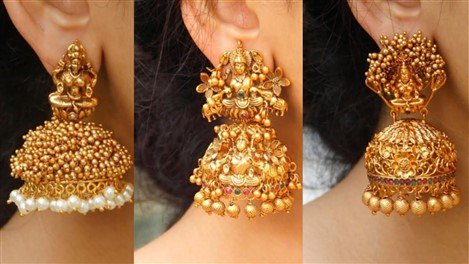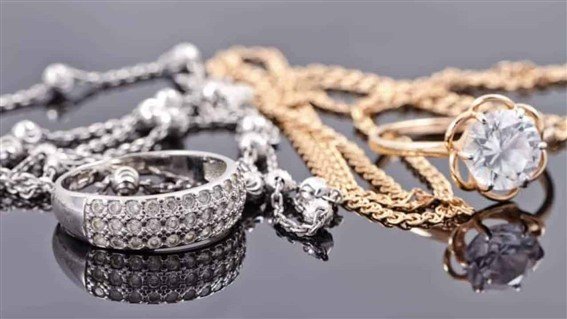
There is a scene in Sex and the City I’ve been thinking about a lot lately. Miranda Hobbs, Carrie Bradshaw’s very dependable and sensible friend, tried to help Carrie’s boyfriend at the time, everyone’s favorite nice guy who finished last Aidan, pick out an engagement ring. Carrie hated the ring. She hated it so much she threw up when she saw it. Dramatic, yes, but she couldn’t understand how the man she could potentially become betrothed to would buy her a gold ring. “But you wear gold,” Miranda said (who could forget Carrie’s cherished “gold” name plate she almost lost in Paris?). “Yeah, ghetto gold for fun!” Carrie shot back flippantly and quickly.
The year was 2001 and there was a certain stigma around wearing too much gold: hoops, rings, necklaces or otherwise. But in 2019, you better believe Bradshaw would have piled on tons of gold jewelry. She would have layered several gold chains and had several gold piercings in her ear, including a big pair of thick gold hoops. You can’t get away from this sort of styling. Your favorite influencers are doing it and so are your favorite jewelry brands. But I just can’t help but wonder when did this shift happen?
In the earlier seasons of Keeping Up With The Kardashians, Kim Kardashian, whose own aesthetic often triggers accusations of cultural appropriation, poked fun at her younger sister Khloe’s style insinuating that it was ‘ghetto.’ And Kylie Jenner’s ex-boyfriend, rapper Tyga takes credit — a separate and problematic issue altogether— for the strategic way the youngest Jenner switched up her style.
View this post on Instagram
A post shared by Kylie (@kyliejenner) on Apr 15, 2018 at 1:48pm PDT
“You gotta look at the before and after,” he told Nicki Minaj last September on the rapper’s Apple Music Beats 1 show Queen Radio. “She always had a platform, and she was always destined to be where she was going to be, regardless. But when I stepped in, and there was a lot of codes being taught, it was like ‘You could do this. You should start this. You should start doing your hair like this, or you should do this,” he said.
“You should adapt because you need Black people to fuck with you, ‘cause you need culture. If you ain’t got Black people behind you, you ain’t got nothing — ain’t nobody going to listen. You can’t influence nobody.’ So I had a lot to do with that.” Cultural critic Jamilah Lemieux tweeted in response: “He wants to be properly credited for helping his white teenaged girlfriend morph into a Canal Street knock-off of a thick light-skinned Black woman.” Are the Kardashians/Jenners to blame here?
View this post on Instagram
Essentials⛓Personalize Your Own™️ (Tap To Shop) c/o @thecon.cept @treverhoehne
A post shared by The M™ (@themjewelers) on Dec 19, 2018 at 12:32pm PST
The Kardashians and Jenners may be some of the more famous faces but they aren’t the only ones who are profiting from this aesthetic. “White women continue to follow and actively copy Black women without flaw,” says Wanna Thompson, a writer and content creator who often critiques mainstream culture for her 24.K followers on Twitter. “They use us as ‘inspo’ and rid of the origin when it’s convenient for them.” Plus, she says, “thanks to Instagram, the now popular “Instagram Baddie” aesthetic that derives from Black women has been watered down and adapted by white fashion/beauty influencers who want to be seen as “cultured” or edgy. “This isn’t a mistake, this is deliberate,” she continues. “Black women have always been ‘what’s cool’ or ‘what’s hot’ and white women know this. Most of us have been wearing gold chains since birth, it’s sort of like a ‘rite of passage’ for many of us. When someone doesn’t have any connection to something and they’re just wearing it to feel included or trendy, you could feel the difference.”
I’m not naive to the fact that this particular aesthetic represents a certain level of cultural cache. That’s why there are girls on Instagram “Blackfishing.” It’s glamorous now to sport multiple chains. I'm also aware that the classist rhetoric surrounding gold can largely — although not exclusively — be attributed to white Western women. There are a number of other communities who celebrate gold jewelry and wear gold jewelry like Asian, Southeast Asian and Hispanic cultures. However, it is hard to ignore the widespread impact Black culture has had on mainstream western society, and to not acknowledge is short-sighted.
The fashion influencers who drape themselves in labels head to toe, and wouldn’t be caught dead wearing a designer knock-off have no problem sporting plated pieces. That’s fake gold. Those Laura Lombardi earrings that are priced at $105 are not real gold. Neither is that $125 M Jewelry Crucifix necklace or the $850 Rachel Comey choker.
In media’s haste to participate and editorialize in this trend, we’re calling simple gold chains with pendants, charm necklaces. And why? To distance the jewelry from the idea that the pieces or the person wearing them from long-standing label of gold being considered ‘ghetto.’ Meanwhile, there are no less than 100 pitches in my inbox for jewelry brands shilling gold pieces, including one with the subject “Wearin' a ring but ain't gon' be no "Mrs."
The rhetoric around gold jewelry is often classist and elitist. “Silver jewelry is cuter than gold because gold looks tacky no matter how expensive it is, I rest my case,” @ufobri wrote in a now-deleted tweet. Shopping articles describe gold hoops as “door knocker" earrings —you know, those attitude-laden hoops that are big and bold enough to literally rap on someone's door—belonged only to gum-snapping teenagers or anyone permanently stuck in the '80s, cautioning that “not every occasion calls for a larger-than-life accessory.”
But like they do with so many other trends, non-Black women often latch onto and let go of the latest craze with little regard to where it originated, while simultaneously perpetuating a pejorative narrative about the demographic group responsible for the trend in the first place. Of course, fashion doesn’t exist in a vacuum, but true allyship acknowledges and pays homage to the community responsible for said trend and doesn’t criminalize the community while essentially gentrifying its style.
#krsuccess #dailylife @successgr.with @steemitblog @pennsif @disconnect @rme @cjsdns @cyberrn @zinasura @raven203 @successgr @dodoim @cyberrn @ilnegro @successgr.with @cryptokannon @francisco01 @whoisjohn @team @successgr.with @dragonslayer109 @noobtube @photoman @royalmacro @chriddi @cryptokannon @francisco01 @steemcurator01 @cmp2020 @inspiracion @cryptokannon @yohan2on @randulakoralage @ngoenyi @bright-obias @fombae @wilmer1988 @tarpan @neerajkr03 @anroja @njiatanga @sm-shagor @sapwood @tocho2 @damithudaya @boss75 @radjasalman @adeljose, @saxopedia @svm038 @xkool24 @alphafx @abuahmad, @amjadsharif, @ghostfacer99, @hassanabid, @lovveday, @sarkodieeric1, @profitfirst @mamraj2020 @helena4h @greris @nsisongudofia @yenny2401 @linheart @hoo04430 @margoth @paholags @irisdaliah @paholags @mayberling @adelvalle @beautifullife-88 @helena4h @greris @nsisongudofia @sd974201 @hive-192096 @cheska22 @kate.alex

Downvoting a post can decrease pending rewards and make it less visible. Common reasons:
Submit